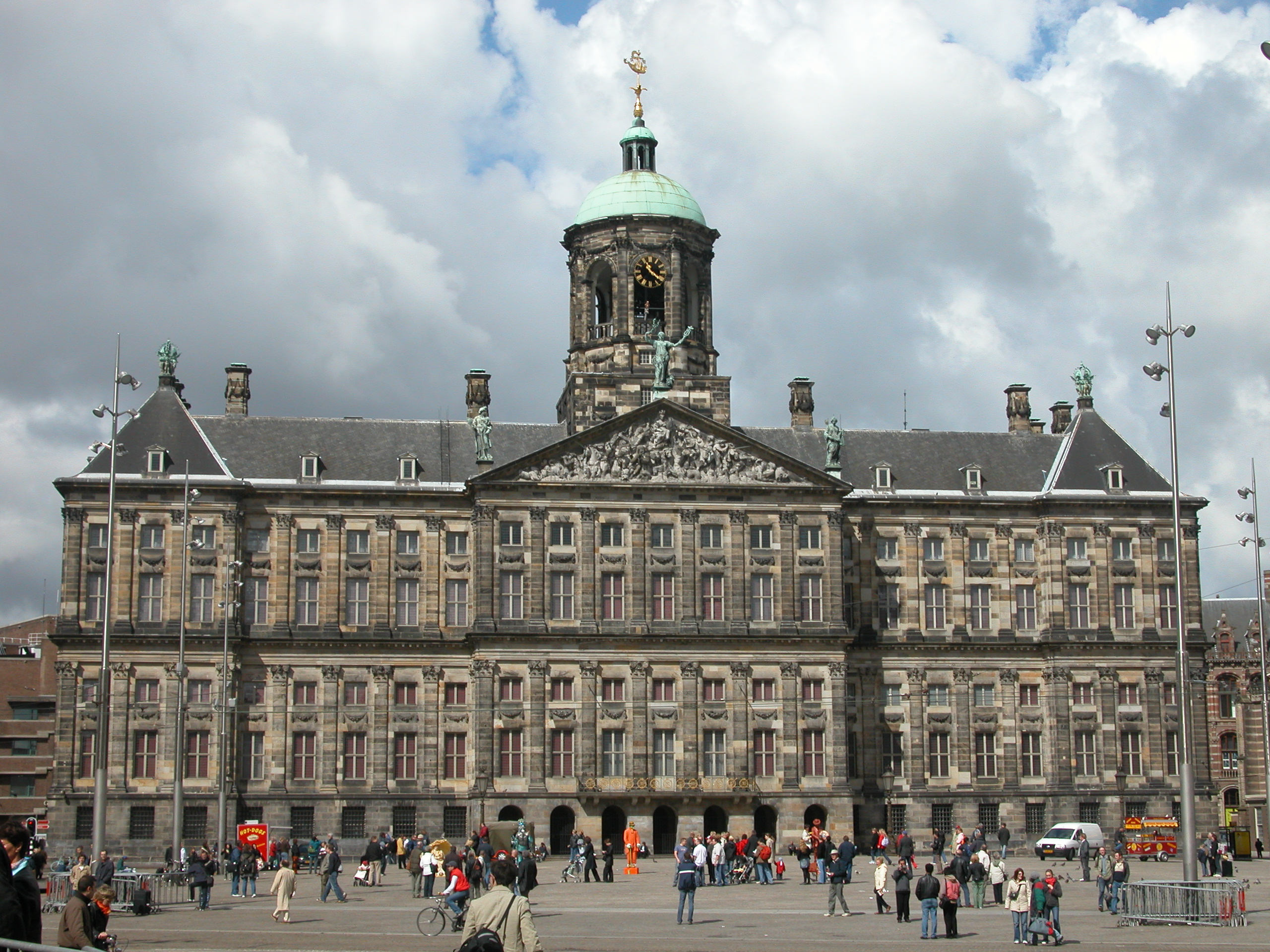- Royal Palace (Amsterdam)
Infobox building
building_name = Royal Palace Amsterdam
native_building_name= Koninklijk Paleis Amsterdam Paleis op de Dam

caption = The Royal Palace Amsterdam in 2005
former_names = Stadhuis op de Dam
map_type =
building_type =
architectural_style =Classicism
structural_system =
cost = ƒ 8.5 million
location =Amsterdam ,Netherlands
address = Nieuwezijds Voorburg 147
client =
owner =Kingdom of the Netherlands
current_tenants = Queen Beatrix
landlord =
coordinates = coord|52.373|4.891|display=inline
start_date = 1648
completion_date = 1665
inauguration_date =20 July 1655
demolition_date =
destruction_date =
height =
diameter =
other_dimensions =
floor_count =
floor_area = 22,031 m2
main_contractor =
architect =Jacob van Campen ,Daniël Stalpaert
structural_engineer =
services_engineer =
civil_engineer =
other_designers =Artus Quellinus ,Govert Flinck ,Jacob Jordaens ,Jan Lievens ,Ferdinand Bol
quantity_surveyor =
awards =
references =The Royal Palace in
Amsterdam ("Koninklijk Paleis te Amsterdam" in Dutch) is one of three palaces in theNetherlands which is at the disposal of Queen Beatrix by Act of Parliament. It is situated in the west side ofDam Square in the centre of Amsterdam, opposite the War Memorial and next to the Nieuwe Kerk.Town hall
The town hall was opened on 20th July
1655 by the leaders of Amsterdam. It is now called the royal palace. It was built byJacob van Campen . He took control of the construction project in1648 , as theTown Hall for the City of Amsterdam. It was built on 13,659 wooden piles and cost 8,5 milliongulden . A yellowishsandstone fromBentheim inGermany was used for the entire building. The stone has darkened considerably in the course of time. Marble was the chosen material for the interior.Jacob van Campen was inspired by Roman administrative palaces. He drew inspiration from the public buildings of
Rome . He wanted to build a new capitol for the Amsterdam burgomasters who thought of themselves as theconsul s of the new Rome of the North. The technical implementation was looked after by the town construction masterDaniël Stalpaert . The sculptures were executed byArtus Quellijn .The central hall is huge: 120 feet long, 60 feet wide and 90 feet high. On the dazzeling richness of the marble floor one sees two maps of the world with a celestial hemisphere. The Western and Eastern hemispheres are shown on the maps. On the hemispheres the colonial influential area of Amsterdam is detailed. The terrestrial hemispheres were made in the mid-18th century. They replaced an earlier pair made in the late 1650s. The originals showed the regions explored by VOC's ships in the first half of the 17th century.
On top of the palace is a large
dome dcupola , topped by a weather vane in the form of a Cog ship. This ship is a symbol of Amsterdam. Just underneath the dome there are a few windows. From here one could see the ships arrive and leave the harbour.The interiors, focusing on the power and prestige of Amsterdam, were completed later.
Paintings inside include works by
Govert Flinck (who died before finishing a cycle of twelve huge canvases),Jacob Jordaens ,Jan Lievens andFerdinand Bol .Rembrandt 's largest work,The Conspiracy of Claudius Civilis was commissioned for the building, but after hanging for some months was returned to him; the remaining fragment is now in Stockholm.In its time the building was one of many candidates for the title of the
Eighth Wonder of the World . Also, for a long time it was the largest administrative building inEurope .Palace
After the patriot revolution which swept the
House of Orange from power a decade earlier, the newBatavian Republic was forced to acceptLouis Napoleon Bonaparte , brother ofNapoleon Bonaparte , as King of Holland in1806 . After holding his court at The Hague and Utrecht, Louis Napoleon moved to Amsterdam, and converted the Town Hall into a royal palace for himself.The King of Holland did not have long to appreciate his new palace. He abdicated on the 2 July
1810 , and the Netherlands was annexed byFrance . The palace then became home to the French governor,Charles François Lebrun .Prince William VI (son of Prince
William V of Orange ), returned to the Netherlands in1813 , after Napoleon fell from power, and restored the palace to its original owners. After his investiture as KingWilliam I of the Netherlands , however, Amsterdam was made the official capital of theUnited Kingdom of the Netherlands (the seats of government beingBrussels andThe Hague ). The new King realised the importance of having a palace in the capital, and the Town Hall again became a royal palace.It was made property of the Kingdom of the Netherlands in
1936 , and is used by the Queen for entertaining and hosting official functions, such as state visits, the New Year reception, and the presentations of theErasmus , Royal Grant to Painting andPrince Claus prizes.External links
* [http://www.koninklijkhuis.nl/content.jsp?objectid=4551 Koninklijk Paleis Amsterdam] at the website of the Dutch Royal House
* [http://www.hotels-amsterdam-netherlands-hotels.com/royal-palace/ Royal Palace Amsterdam] Independant article and photographs of the Palace in Dam Square.
Wikimedia Foundation. 2010.
